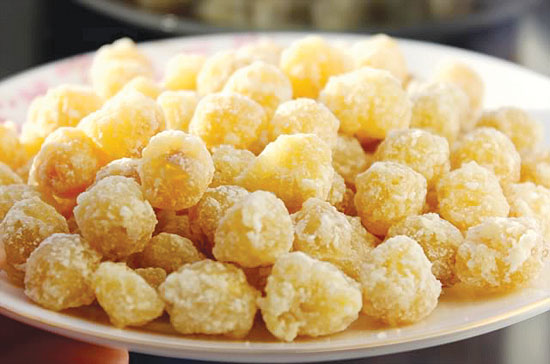No 11, Vol.5, December 2015 – January 2016

Photos by courtesy of triducfood.com.vn
Lotus grows in all regions of our country. The further south one goes, the more lotuses can be seen. Especially in Dong Thap Province, they grow everywhere, even in paddy fields. Nothing of a lotus plant is wasted. The leaves, seeds, stems and roots, all add colours, tastes and aromas to different Vietnamese foods.
Since ancient times, people have learned to use lotus seeds in various highly nutritious foods, such as lotus pudding, sugar-coated lotus seeds, lotus and longan compote, lotus and bean porridge, and lotus and chicken stew. Sugar-coated lotus seeds are not only delicious and nutritious, but also a traditional medicine which soothes chronic diarrhoea, amnesia and nutritional deficiency.
Being a significant sacrament in Vietnamese spiritual life, lotus is also present in what is best of our culinary culture. Parts of the lotus plant are used in the most common Vietnamese food items, such as lotus root-stock salad, lotus-scented tea, and sugared lotus seeds. The sugar-coated seeds are especially valued, not only during the New Year celebration, but also on many other happy occasions, such as engagement and wedding ceremonies. Aromatic sweet seeds coquettishly wrapped in red glass paper and tied to a packet of tea and a green sticky rice cake makes them divine.
Beside the sweets made of squash, coconut, and ginger, each translucent yellow lotus seed stands out like a jewel. Chewed with a sip of bitter tea, especially scented tea, which carries a delicate touch of fresh aroma, it makes one’s experience both fancy and tranquil. The sugar-coated seeds can also be used to make all sorts of sweet-flavoured puddings and compotes. They are also often a part of the beloved mid-autumn cakes.
Everyone who has visited Vietnam has spared no words to extol lotus. They say that the Vietnamese are blessed by heaven with this gift. Lotus leaves are like green suns. The flowers are as refined as the Vietnamese girls. The seeds are gems between heaven and earth. The more the society changes, the more human life advances, the more sophisticated and delicate foods will appear in our festivities and on our dining tables. But hopefully the New Year sweets, especially the sugar-coated lotus seeds will remain with us forever.n
*The article was printed on triducfood.com.vn
The elders of Nanh Village, Ninh Hiep Commune of Hanoi say that sugaring lotus seeds is a painstaking business. To make the famous ‘naked lotus seeds’ of Hanoi, the seeds must be meticulously filtered. The Northern lotus is best because it’s rounder, more aromatic and crumbly. It requires delicacy to break the hard husk without breaking the seed. It’s also difficult to remove the green bud, which is very bitter, in its entirety from centre of the seed. Up until now, only Nanh Village owned the secret of chopping the lotus seed husk. The seeds must be boiled in water several times, with different durations and heat levels, to make the seeds melt away in the mouth but firm enough to stay in shape. At the sugaring stage, the sugar must be absorbed inside the seeds. Only then they can look gem-like. And the sugar solution must be seasoned with pomelo flower oil to create the unforgettable impression associated with this fabulous sweet.
Customers can buy sugared lotus seeds made by Nanh Village at FairFood Company at VND100,000/kg. FairFood Company, Room 14.1, Building CT1 – Vimeco, Hoang Minh Giam St, Cau Giay Dist., Hanoi. Tel: (04) 2225-0531

